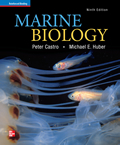
Marine Biology (Castro), 9th EditionChapter 18: The Impact of Humans on the Marine EnvironmentFor Further ReadingAllen, I., 2004. Will Tuvalu disappear beneath
the sea? Smithsonian, vol. 35,
no. 4, August, pp. 44–52. Rising seas
and increasing storms that may be
caused by global warming raise fears
about the future of Tuvalu, a tiny island
nation in the southwestern Pacific. Alley, R. B., 2004. Abrupt climate change. Scientific American, vol. 291, no. 5, November, pp. 62–69. Sudden shifts in climate, like one that may be brought about by a shift in the North Atlantic conveyor, may be a symptom of global warming. Bourne, J. K., 2004. The big uneasy. National Geographic, vol. 206, no. 4, October, pp. 88–105. The coast of Louisiana is rapidly being eroded away as the result of dredging and other factors. Graham-Rowe, D., 2004. Breaking up is a hard thing to do. Nature, vol. 429, 24 June, pp. 800–802. The good news is that old, single-hulled tankers are being scrapped, the bad news is that the recycling process spreads toxic chemicals. Hansen, J., 2004. Defusing the global warming time bomb. Scientific American, vol. 290, no. 3, March, pp. 68–77. Practical actions by governments and people may slow down or even stop global warming. S. K. Hooker and L. R. Gerber, 2004. Marine reserves as a tool for ecosystem-based management: the potential importance of megafauna. BioScience, vol. 54, no. 1, pp. 27-39. Whales and large predators are important as indicators of biodiversity in the establishment of pelagic marine reserves around the world. Krajick, K., 2004. Medicine from the
sea. Smithsonian, vol. 35, no. 2, May,
pp. 50–59. Marine organisms from
many habitats are being investigated as
sources of new medications. Margonelli, L., 2003. Fried ice. Discover, vol. 24, no. 11, November. Moore, C., 2003. Trashed. Natural History, vol. 112, no. 9, November, pp. 46–51. Plastic waste pollutes the open North Pacific. Nicholls, H., 2004. Sink or swim. Nature, vol. 432, no. 7013, 4 November, pp. 12–14. The establishment of marine protected areas on the high seas is seen as a way to conserve valuable biodiversity and fishing resources. Stassny, M. L. J., 2004. Saving Nemo. Natural History, vol. 113, no. 2, March, pp. 50–55. The economic impact of aquaria may ultimately help conserve some marine habitats. Williams, C., 2004. Battle of the bag. New Scientist, vol. 183, no. 2464, 11 September, pp. 30–33. Plastic bag fragments enter the marine environment in increasing amounts, something that has prompted many nations to take drastic control methods. Cesar, H. S. J. and P. J. H. van Beukering, 2004. Economic valuation of the coral reefs of Hawaii. Pacific Science, vol. 58, pp. 231–242. Coles, S. L. and B. E. Brown, 2003. Coral bleaching—capacity for acclimatization and adaptation. Advances in Marine Biology, vol. 46, pp. 183–223. Forde, S. E., 2002. Modelling the effects of an oil spill on open populations of intertidal invertebrates. Journal of Applied Ecology, vol. 39, no. 4, pp. 595–604. Gray, J. S., 2002. Biomagnification in marine systems: The perspective of an ecologist. Marine Pollution Bulletin, vol. 45, no. 1, pp. 46–52. Grosholz, E.D. and G. M. Ruiz, 2003. Biological invasions drive size increases in marine and estuarine invertebrates. Ecology Letters, vol. 6, no. 8, pp. 700–705. Herborg L. M., S. P. Rushton, A. S. Clare and M. G. Bentley, 2003. Spread of the Chinese mitten crab (Eriocheir sinensis H. Milne Edwards) in Continental Europe: analysis of a historical data set. Hydrobiologia, vol. 503, no. 1–3, pp. 21–28. Kaiser, M. J., 2003. Detecting the effects of fishing on seabed community diversity: importance of scale and sample size. Conservation Biology, vol. 17, no. 2, pp. 512–520. Lafferty, K. D., J.W. Porter and S. E. Ford 2004. Are diseases increasing in the ocean? Annual Review of Ecology, Evolution, and Systematics, vol. 35, pp. 31–54. McConnell, M., 2003. Ballast and biosecurity: The legal, economic and safety implications of the developing international regime to prevent the spread of harmful aquatic organisms and pathogens in ship’s ballast water. Ocean Yearbook, vol. 17, pp. 213–255. Secord, D., 2003. Biological control of marine invasive species: cautionary tales and land-based lessons. Biological Invasions, vol. 5, no. 1–2, pp. 117–131. Shivji, M., S. Clarke, M. Pank, L. Natanson, N. Kohler and M. Stanhope, 2002. Genetic identification of pelagic shark body parts for conservation and trade monitoring. Conservation Biology, vol. 16, no. 4, 1036–1047. Smith, J. E., C. L. Hunter, E. J. Conklin, R. Most, T. Sauvage, C. Squair and C. M. Smith, 2004. Ecology of the invasive red alga Gracilaria salicornia (Rhodophyta) on O‘ahu, Hawaii. Pacific Science, vol. 58, pp. 325–343. http://www.millenniumassessment.org/en/index.aspx |  |















